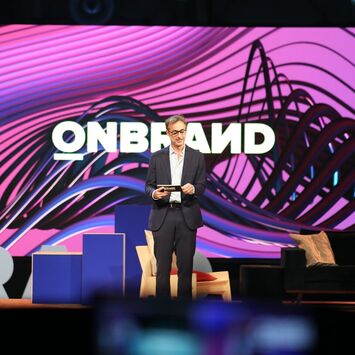Thanks to the rise of AI and the failings of data management, the new face of marketing technology is both more and less human.
For years, marketers have been talking about data, collecting it and preparing for the coming revolution. But something new has happened on the road to utopia: the volume and variety of data have exploded. No longer rare and hard to gather, data is everywhere, and organizations are failing to keep up with its variability and quantity.
No longer data deprived, these companies have become data blind, over their heads in information they can’t properly distill or draw insight from. As a result, we’ve seen marketers forced to spend their time managing disparate information streams rather than focusing on actually engaging with and getting to know their customers.
Luckily, real-time tools using AI machine intelligence have emerged to help modern companies overcome this issue. The result? Better, more personalized customer experiences that abide by new rules of engagement in our evolving field. Somewhat ironically, AI is driving this shift in the form of marketing intelligence. By automating the time-consuming elements of data collection and analysis, the face of modern “Martech” is at once more, and less, human than ever.
Defects in data land
In 2016, Amazon CTO Werner Vogels received a peculiar cold email pitch which he shared on Twitter. As reported by Business Insider, a salesman emailed Vogels to inquire whether his company was considering cloud computing. The pitch was laughably bad because Vogels heads up AWS (Amazon Web Services), Amazon’s massive and disruptive cloud service. It’s like trying to sell America to Thomas Jefferson (nice try, he’s a founding father.)
Vogels' response really gets at the heart of the issue: B2B marketers, like the one that pitched cloud services to Amazon, are equipped with bad data and poorly-utilized automation tools. They may have the right information somewhere, but if their tools aren’t using it with accuracy, they are engaging in all the wrong ways.
The result of such efforts can be useless at best, and embarrassing or devastating to businesses at worst.
In an age when we have access to so much data, why do B2B marketers keep missing the mark? It’s easy to poke fun at mistakes like the Amazon cold pitch, but the issue is more complex and widespread than you might think.
Here are three main reasons data misuse persists:
1. Too many tools
Access to mass amounts of data is a blessing and a curse for businesses. A blessing because it is rich with insight, and a curse because it’s often fragmented across dozens of tools that don’t communicate or sync up. OnBrand's State of Branding report found that brands want to personalize but struggle to navigate through the crowded Martech landscape.
2. Loss of leverage
As a result of this fragmentation, marketers are losing leverage with the people they need to reach, who (rightfully) expect a lot, and must be wooed into making decisions. Companies are losing out on opportunities to engage and falling back on tired approaches.
3. Suffering skills
The glut of unusable data is keeping marketers from reaching their goals. They spend so much time attempting to wrangle data that their own abilities haven’t kept up, creating a data skills gap.
The promised land is close: if we can centralize the data, leverage it, and coordinate all channels, companies can deliver a better customer experience in the same way Netflix and Amazon do: through personalization driven by marketing intelligence. In this way, AI will lead the charge for more personal experiences in B2B and beyond.
Its popularity is certainly growing. According to Salesforce as reported by Business Insider’s AI Marketing Report, “Just over half (51%) of marketers currently use AI, and an additional 27% are expected to incorporate the technology by 2019.”
Once companies stop chasing the data and learn how to use it, the insights needed to truly engage and connect will follow—easily, and without the need for IT intervention. This will lead to more buyers, increased revenue, and fully-optimized customer experiences.
Engagement 2.0: Becoming more human
Even in B2B, companies are marketing to people, not faceless “businesses” with no taste or personality. This is why some have begun reframe B2B as B2P, or business-to-people marketing.
Which makes sense when you consider that average of 8 buyers are involved in the B2B decision process, each with unique buyer journeys. Every buyer has a different nuanced persona and requires different approaches at different times—a one size fits all targeting plan will more than likely backfire.
According to the report “From Promotion to Emotion” by The Corporate Executive Board (CEB) and Google, “B2B brands that connect with their buyers on an emotional level earn twice the impact over marketers who are still trying to sell business or functional value.”
In other words, just quantity of leads or ads is not enough unless you’ve tailored your approach for accuracy, relevance, and yes, human emotion. The newest rules in marketing dictate a more human approach that is becoming difficult to achieve without AI’s help.
Marketo CEO Steve Lucas explained some of these new rules to Forbes in a 2017 interview. Lucas brings up the idea of deterministic marketing, in which brands make marketing decisions based on buyers’ and customers’ "personal values, professional values, lifestyles, wants and needs and more" as the only form of true engagement.
Today, what passes for engagement in marketing is often pitiful, based purely on detached factors like age, zip code, and income level. According to Lucas, “that inferential approach, with no truly personal metrics, is not engagement—and it won't work! Instead, that has to be replaced with a more deterministic approach based on a rich and multidimensional digital profile of you: what mood you're in at a certain time, what's the best channel to use to reach you at various stages, and what type of message to use that will resonate with you."
AI gets personal
Personality metrics and deterministic marketing are more than possible. While the issues we’re seeing with data are relatively new, they can’t be ignored—especially as experts predict a 4,300% increase in annual data production by 2020.
AI is a leading tool because it can process and make sense of data overload, disparate data, dirty data, and dated data. It can also streamline communications and leverage information in real-time, so that every experience is uniquely and expertly tailored.
There are several companies capitalizing on AI as the new tool for personalization (Full disclosure: my own company, CaliberMind, is one of them). Lucas’ company Marketo happens to be another. Its cutting-edge software leverages data from content consumption trends, profiles, and behavior patterns to “learn” and suggest content that will resonate. These AI-powered suggestions are ushering in what Marketo calls “The Age of the Empowered AI Marketer,” in which AI enhances marketing expertise by “turning data into intelligent action at scale.”
Another example is Drift, which focuses its marketing intelligence on lead forms. Instead of traditional marketing and sales platforms that rely on forms and follow-ups, Drift uses AI to connect your business with the best leads in real-time, acting as a virtual sales assistant for your website. How does this humanize the process? Drift’s AI connects leads with the right team member based on their inquiries, or answers them based on prior responses. In this way, the human intelligence of the team is being made more efficient and more personal.
A marketing intelligence revolution?
It’s natural to be cautious about AI when it’s on the margins of our industries, creeping into familiar territory and threatening to change the game. But when the game needs changing, we must seek out disruption or else be the ones disrupted.
It’s B2B’s time to say goodbye to wasteful, time-consuming data management and welcome marketing intelligence with open arms. Buyers and customers expect better than irrelevant, mindless interactions that fail to take the nuances of who they are and what they are looking for into account. The only way to improve this is to use all the data you have, and use it well.
AI allows marketers to spend more time on the emotional skills that are so important in our industry. Its introduction as a tool is also light years better than the alternative: reams of dirty and disparate data holding companies back from the engagement they need to succeed in today’s information economy.
Call it more human, less human, or both—we need it because it works, and it works because we need it.









